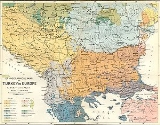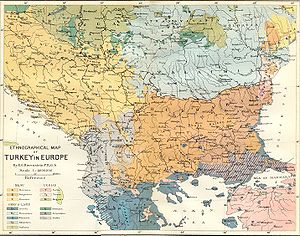
Ernst Georg Ravenstein
Encyclopedia

Germany
Germany , officially the Federal Republic of Germany , is a federal parliamentary republic in Europe. The country consists of 16 states while the capital and largest city is Berlin. Germany covers an area of 357,021 km2 and has a largely temperate seasonal climate...
-English
England
England is a country that is part of the United Kingdom. It shares land borders with Scotland to the north and Wales to the west; the Irish Sea is to the north west, the Celtic Sea to the south west, with the North Sea to the east and the English Channel to the south separating it from continental...
geographer
Geography
Geography is the science that studies the lands, features, inhabitants, and phenomena of Earth. A literal translation would be "to describe or write about the Earth". The first person to use the word "geography" was Eratosthenes...
cartographer
Cartography
Cartography is the study and practice of making maps. Combining science, aesthetics, and technique, cartography builds on the premise that reality can be modeled in ways that communicate spatial information effectively.The fundamental problems of traditional cartography are to:*Set the map's...
and promoter of physical exercise. As a geographer he was less of a traveller than a researcher; his studies led mainly in the direction of cartography and the history of geography.
Geography
Ravenstein was born in Frankfurt am Main, GermanyGermany
Germany , officially the Federal Republic of Germany , is a federal parliamentary republic in Europe. The country consists of 16 states while the capital and largest city is Berlin. Germany covers an area of 357,021 km2 and has a largely temperate seasonal climate...
to a family of cartographers. When he was 18 years old he became a pupil of Dr. August Heinrich Petermann
August Heinrich Petermann
August Heinrich Petermann was a German cartographer.-Early years:Petermann was born in Bleicherode, Germany. When he was 14 years old he started grammar school in the nearby town of Nordhausen...
. After moving to England
England
England is a country that is part of the United Kingdom. It shares land borders with Scotland to the north and Wales to the west; the Irish Sea is to the north west, the Celtic Sea to the south west, with the North Sea to the east and the English Channel to the south separating it from continental...
, Ravenstein became a naturalized
Naturalization
Naturalization is the acquisition of citizenship and nationality by somebody who was not a citizen of that country at the time of birth....
British Subject
British subject
In British nationality law, the term British subject has at different times had different meanings. The current definition of the term British subject is contained in the British Nationality Act 1981.- Prior to 1949 :...
and was in the service of the Topographical Department of the British War Office
War Office
The War Office was a department of the British Government, responsible for the administration of the British Army between the 17th century and 1964, when its functions were transferred to the Ministry of Defence...
for 20 years (1855–75). A long-serving member of the councils of the Royal Statistical
Royal Statistical Society
The Royal Statistical Society is a learned society for statistics and a professional body for statisticians in the UK.-History:It was founded in 1834 as the Statistical Society of London , though a perhaps unrelated London Statistical Society was in existence at least as early as 1824...
and Royal Geographical
Royal Geographical Society
The Royal Geographical Society is a British learned society founded in 1830 for the advancement of geographical sciences...
Societies, he was also Professor
Professor
A professor is a scholarly teacher; the precise meaning of the term varies by country. Literally, professor derives from Latin as a "person who professes" being usually an expert in arts or sciences; a teacher of high rank...
of Geography at Bedford College in 1882–83. He was the first to receive the Victoria gold medal
Gold Medal (RGS)
The Gold Medal are the most prestigious of the awards presented by the Royal Geographical Society. The Gold Medal is not one award but consists of two separate awards; the Founder's Medal 1830 and the Patron's Medal 1838. The award is given for "the encouragement and promotion of geographical...
of the Royal Geographical Society (1902) for geographical research.
His statistics and projections were much respected and used as a basis for official planning at the time; he had even predicted that human population would grow beyond the earth's capacity
Carrying capacity
The carrying capacity of a biological species in an environment is the maximum population size of the species that the environment can sustain indefinitely, given the food, habitat, water and other necessities available in the environment...
by the mid-20th century. (Subsequent developments in agriculture and fertilizer
Fertilizer
Fertilizer is any organic or inorganic material of natural or synthetic origin that is added to a soil to supply one or more plant nutrients essential to the growth of plants. A recent assessment found that about 40 to 60% of crop yields are attributable to commercial fertilizer use...
s have altered the basis of that projection.)
He established a theory of human migration in the 1880s that still forms the basis for modern migration theory. It considered the implications of distance and different types of migrant, with women more likely than men to migrate within the country of their birth but less likely than men to leave the country of their birth.
Gymnastics
In 1861 Ravenstein established the German Gymnastics Society, a sporting association, in London. It promoted gymnastics and held annual athletic competitions, at a purpose-built German GymnasiumGerman Gymnasium, London
The German Gymnasium is in Pancras Road, London close to the new international railway station of St Pancras. It was constructed in 1864-65 for the German Gymnastics Society, a sporting association established in London in 1861 by Ernst Ravenstein...
in St Pancras and at The Crystal Palace
The Crystal Palace
The Crystal Palace was a cast-iron and glass building originally erected in Hyde Park, London, England, to house the Great Exhibition of 1851. More than 14,000 exhibitors from around the world gathered in the Palace's of exhibition space to display examples of the latest technology developed in...
. With William Penny Brookes
William Penny Brookes
Dr. William Penny Brookes was an English surgeon, magistrate, botanist, and educationalist especially known for his promotion of physical education and personal betterment...
and John Hulley, he was a founder member of the National Olympian Association
British Olympic Association
The British Olympic Association is the national Olympic committee for Great Britain and Northern Ireland. It was formed in 1905 in the House of Commons, and at that time consisted of seven national governing body members from the following sports: fencing, life-saving, cycling, skating, rowing,...
in 1866, which promoted an annual series of sporting events across the country, inspired by the Olympic Games of Much Wenlock
Wenlock Olympian Society Annual Games
The Wenlock Olympian Society Annual Games, dating from 1850, are a forerunner of the modern Olympic Games. They are held each year in Much Wenlock in Shropshire, England.-Overview:...
. He published a handbook on gymnastics in 1867.
Although he spent most of his adult life in England, with a house at Lorn Rd, Lambeth
Lambeth
Lambeth is a district of south London, England, and part of the London Borough of Lambeth. It is situated southeast of Charing Cross.-Toponymy:...
, he died in Germany on 13 March 1913.
Printed works
His Systematic Atlas (1884) put into practice many his ideas as to methods of teaching cartography. The Philips's World Atlas was published with Ravenstein's plates and statistics for several decades.His Map of Equatorial Africa (1884) was the most notable map of a large part of the continent on a large scale that had been made up to that time, and he immediately developed it as new discoveries were made in Central and Eastern Africa.
Ravenstein also published:
- Vasco da Gama's First Voyage (1898)
- The Russians on the Amur (1861) (Full text can be found on Google Books).
- Handy Volume Atlas (1895; seventh edition, 1907)
- Martin BehaimMartin BehaimMartin Behaim , was a German mariner, artist, cosmographer, astronomer, philosopher, geographer and explorer in service to the King of Portugal.-Biography:The Behaim family had immigrated to Nuremberg because of religious persecution around...
. His Life and his GlobeErdapfelThe Erdapfel produced by Martin Behaim in 1492 is considered to be the oldest surviving terrestrial globe. It is constructed of a laminated linen ball in two halves, reinforced with wood and overlaid with a map painted by Georg Glockendon....
(1908) - A Life's Work (1908)
- The New Census Physical, Pictorial, and Descriptive Atlas of the World (1911)
- History of cartography article for the 1911 Encyclopædia Britannica's 'Map' entry.

